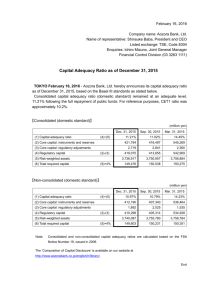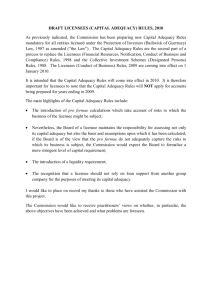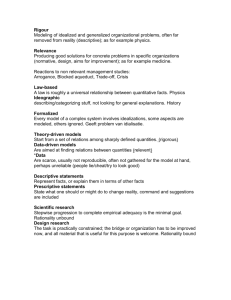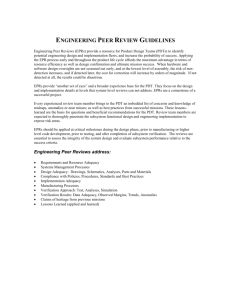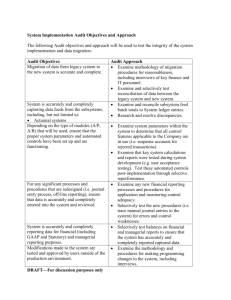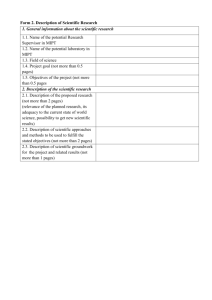Guidelines on Stress Test Requirement for Long Term Insurers
advertisement
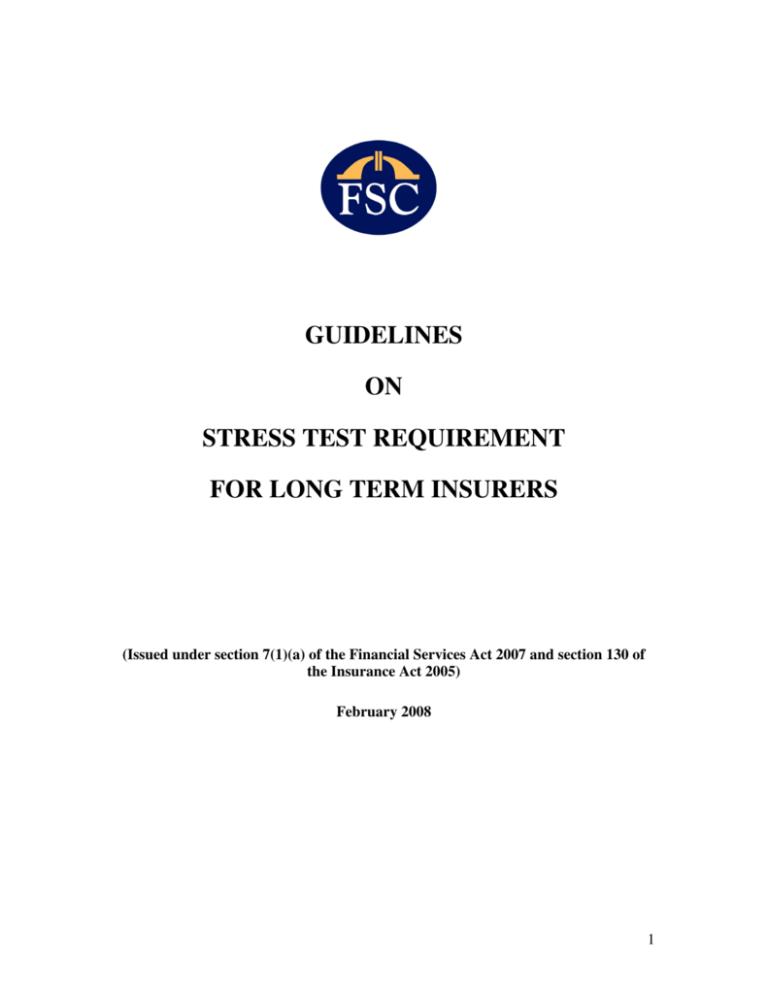
GUIDELINES ON STRESS TEST REQUIREMENT FOR LONG TERM INSURERS (Issued under section 7(1)(a) of the Financial Services Act 2007 and section 130 of the Insurance Act 2005) February 2008 1 1. INTRODUCTION 1.1 The objective of the Guidelines on Stress Test Requirement for Long Term Insurers (the “Guidelines”) is to assist long term insurers in calculating the stress test requirement, as required by the Insurance (Long Term Insurance Business Solvency) Rules 2007. 1.2 Pursuant to its powers, the Guidelines are issued by the Commission under section 7(1) (a) of the Financial Services Act 2007 and section 130 of the Insurance Act 2005. 1.3 The Guidelines are meant to provide the minimum standards. It is not intended to replace or override any provisions under the law. The Guidelines should be read in conjunction with the provisions of the Insurance Act 2005, regulations made thereunder and any other rules, guidelines, circulars and notices that the Commission may issue from time to time. 1.4 Non-compliance with the Guidelines will expose the licensee to regulatory actions which may include a direction under section 7(1) (b) of the Financial Services Act 2007 to ensure compliance with the Guidelines. Failure to comply with the direction may lead to regulatory actions. 1.5 The Guidelines shall apply to all long term insurers. 1.6 The Guidelines may be subject to review and may be amended by the Commission from time to time. 2. STRESS TEST REQUIREMENTS The use of best-estimate valuation assumptions, adjusted by the prescribed margins and any additional discretionary margins, aims to ensure that the long term insurer should have sufficient assets to meet its future liabilities in respect of its existing in-force business if actual experience deviates from the valuation assumptions. In addition, to protect the solvency of an insurer against unexpected adverse shocks, the excess of assets over liabilities need to be sufficient to meet its ongoing liabilities. The minimum amount of assets that an insurer should hold in excess of its liabilities is referred to as its Stress Test Requirement. 2.1 Stress Test Requirement: The purpose of stress test requirement is to quantify the minimum level of assets in excess of liabilities: 2.1.1. so as to enable the insurer to meet all the obligations as and when they are due; 2.1.2. to provide sufficient cushion against adverse deviations in experience in any of the variables used in the valuation of liabilities as required by the Insurance (Long Term Insurance Business Solvency) Rules, 2007. 2.2 Stress Test Requirements equals the higher of the "Termination Capital Adequacy Requirements" (TCAR) and the "Ordinary Capital Adequacy Requirements" (OCAR), as defined in 2.3 and 2.4 below. 2 2.3 "Termination Capital Adequacy Requirements" (TCAR): 2.3.1 TCAR = Lapse capital adequacy requirement + Surrender capital adequacy requirement, as defined in 2.3.2 and 2.3.3 below: 2.3.2 Lapse capital adequacy requirement (for policies with no surrender values): The lapse capital adequacy requirement equals the amount required to ensure that no policy has a negative liability, where liability refers to the total amount of liability as determined by Insurance (Long Term Insurance Business Solvency) Rules 2007, before taking any other capital adequacy requirements into account. 2.3.3 Surrender capital adequacy requirement: The surrender capital adequacy requirement equals the amount required to ensure that no policy's liability is less than its current surrender value or guaranteed surrender value whichever is higher. For policies that cannot be surrendered or transferred from long term insurer the amount is zero. 2.4 Ordinary Capital Adequacy Requirements (OCAR): 2.4.1 The OCAR is estimated on the basis of a formula, which comprises of a factorbased approach that isolates each major risk category and establishes what capital needs to be held in respect of that risk. 2.4.2 The OCAR needs to allow for the effect of a fall in the fair value of the assets backing it, so that a sufficient level of capital is maintained even after such a fall in asset values. 2.4.3 A fall in the fair value of assets is allowed for by initially calculating an Intermediate Ordinary Capital Adequacy Requirement (IOCAR). 2.4.4 OCAR , the ordinary capital adequacy requirement is then calculated by grossing up IOCAR for the effect of the assumed fall in fair value of the assets backing it, as described in paragraph 2.5.8.2 For example should only equities be used to back the OCAR and the assumed fall for equities is 30% then OCAR = IOCAR 0 .7 2.4.5 Should OCAR be backed by cash then OCAR = IOCAR 2.4.6 Should a balanced portfolio be available to back OCAR then OCAR will be built up starting with the less volatile assets. 2.4.7 Example: 2.4.7.1 Cash, fixed interest and equities are available as free assets. For the purpose of this example, assume falls in fair values of 0%, 10% and 30% respectively and the IOCAR is more than the sum of the value of the cash and 90% of the fixed interest assets. 3 2.4.7.2 Then OCAR = Cash amount (c) + Value of fixed interest assets (fi) + Value of equities (e) Where IOCAR = c + 0.9fi + 0.7e 2.4.7.3 It is not necessary to take into account the fall in the fair value of the free assets which are not needed to cover OCAR. 2.4.8 The IOCAR is calculated according to the following formula: IOCAR= (a ² + b² + ci ² + cii ² + ciii ² + d ² + e² + f ² + g ² + h² + i ²) + j where item (a) to item (j) in the formula refer to the capital adequacy requirements as defined in paragraphs 2.5.1 to 2.5.10. 2.4.9 The sum of all groups must be taken in respect of each item above before squaring. If in respect of lapses (i.e. item a), if there are 2 groups namely x and y, then a2 = (ax+ay)2, where ax and ay are the lapse capital adequacy requirement for groups x and y respectively. The capital adequacy requirement should generally be higher where groups are used instead of bundling all policies, since expected profits in one group may not be used to reduce expected losses in another group (i.e. the capital adequacy requirement in respect of a group e.g. ax must be greater to or equal to zero.) 2.4.10 Each of the components of the IOCAR formula is described in detail in 2.5. 2.5 IOCAR COMPONENTS: 2.5.1 ITEM (a): Lapse risk (for policies with no surrender values): 2.5.1.1 The lapse risk capital adequacy requirement equals 40% of the amount required to ensure that no policy has a negative liability before taking into account the effect of any negative bonus stabilisation reserve. 2.5.1.2 Additions to the above amount must be considered where I. the office's lapse experience fluctuates significantly from year to year or the trend in lapses has been worsening over time; II. the typical level of base lapses is in excess of 20% of policies that could lapse per annum. 2.5.2 ITEM (b): Surrender risk: 2.5.2.1 The surrender risk capital adequacy requirement equals 20% of the amount required to ensure that no policy's liability, before taking into account the effect of any negative bonus stabilisation reserve, is less than its current surrender value or its guaranteed surrender value whichever is higher. For policies which cannot be surrendered or transferred from the long term insurer, e.g. certain retirement annuities, the amount is zero. 2.5.2.2 Additions to the above amount must be considered where: I. surrender values are guaranteed (say 40% instead of 20% if guarantees apply at all durations); 4 II. the office has created expectations of stabilised future surrender values at the point of sale or in regular correspondence with policyholders; III. the typical level of surrenders is in excess of 10% of in- force policies per annum. 2.5.3 ITEM (c): Mortality, morbidity and medical fluctuation risk: 2.5.3.1 The required OCAR provides for fluctuations in experience over the year up to the next valuation. 2.5.3.2 The medical fluctuation risk OCAR is set at 3 times the mortality fluctuation risk OCAR 2.5.3.3 The requirements are as follows: (i) (ci): Mortality- 45 p (ii) (cii): Morbidity- (iii) (ciii) Medical- n ; 65 p n ; 135 p n ; where n = number of lives assured in the category (net of lives fully reinsured) and p = annual risk premium on the valuation basis or expected strain (net of reinsurance). 2.5.3.4 Notes: I. The above formulae are based on typical spreads of risks. Where this is not the case (i.e. not a typical spread of risks), the actuary should consider calculating separate fluctuation capital adequacy requirements for different homogeneous groups and holding the sum of these capital requirements; II. The fluctuation risk can be decreased to a large extent by suitable reinsurance. Whilst it is not practical to prescribe formulae which depend on reinsurance arrangements, the actuary may make an adjustment for reinsurance where this can be justified. III. Mortality includes accident benefits; IV. Morbidity includes lump sum disability benefits, dread disease benefits and income protection benefits. V. Medical includes hospital cash plans and major medical benefits. VI. `p’ should include any relevant option premiums. 5 2.5.4 ITEM (d): Annuitant mortality fluctuation risk: 2.5.4.1 Similar to item (c), the OCAR provides for fluctuations in experience over the year up to the next valuation. 2.5.4.2 The annuitant mortality fluctuation capital adequacy requirement equals r n where r = statutory solvency reserves for the relevant (i.e. where mortality plays a role) annuity portfolios on the valuation date; and n = number of annuitants in the relevant category. 2.5.5 ITEM (e): Mortality, morbidity and medical assumption risk: 2.5.5.1 The Aids assumption capital adequacy requirement is equal to one-third of the bestestimate Aids liability. 2.5.5.2 The mortality, morbidity and medical assumption capital adequacy requirement for business with liabilities not valued on a discounted cash flow basis is equal to the sum of the following requirements: I. Mortality: the effect of a 5% heavier mortality experience than the actuary’s valuation basis on the statutory solvency method. II. Morbidity: the effect of a 10% heavier morbidity experience than the actuary’s valuation basis on the statutory solvency method. III. Medical: the effect of a 15% heavier medical experience than the actuary’s valuation basis on the statutory solvency method. 2.5.5.3 Notes: i.Mortality, morbidity and medical include the same benefits as described in the notes to 2.5.3.4 ii.Additions to the above amounts must be considered: (a) For new types of benefits; (b) New distribution channels; (c) Insufficient experience data being available; (d) Experience worsening over time; (e) Any other relevant factor iii.Where the mortality risk is eliminated by the use of back-to-back policies, there are no mortality assumption capital adequacy requirements. iv.The divergent experience as set out above must be assumed to last for the expected time that it would take to react to a divergence of experience by adjusting risk premiums. In cases where risk premiums cannot be adjusted, the divergent 6 experience must be taken into account for the outstanding term of each policy. 2.5.6 ITEM (f): Expense fluctuation risk: 2.5.6.1 The expense fluctuation capital adequacy requirement equals 10% of all renewal expenses in the previous year (excluding commission and commission-related and other acquisition costs). 2.5.6.2 An addition to the above amount must be considered where i. The long-term insurer is rapidly growing and expenses are unpredictable; ii. New business figures historically have deviated by more than 20% from budgets; iii. The long term insurer has recently launched a new class of contract with a substantially different expense structure to existing contracts; 2.5.7 ITEM (g): Expense assumption risk: The expense assumption capital adequacy requirement, for business with liabilities not valued on a discounted cash flow basis, equals the increase in liabilities, should allowance be made for a 2% worse inflation rate for renewal expenses (i.e. maintenance, investment and claims expenses) lasting for the duration of the expected reaction time, or for the outstanding term of each policy if expense loadings cannot be reviewed. (The effect of discontinuances must be taken into account.) 2.5.8 ITEM (h): Investment risk: 2.5.8.1The investment capital adequacy requirement is equal to the greater of h(i) and h(ii) as defined in 2.5.8.2 and 2.5.8.3 below. 2.5.8.2 ITEM h(i): Resilience capital adequacy requirement: i. The purpose of the resilience capital adequacy requirement is to test the robustness of the financial position of a long term insurer in the face of volatile market conditions. The actuary must reconsider the statutory solvency valuation, assuming the fall in the fair values of the assets as prescribed in Table: 2.5.8.2 backing the liabilities on the valuation date: Table: 2.5.8.2 S.No Type of asset 1 Fall in fair value Equities: i Listed in Mauritius or listed on such 20% fall in value exchanges as are specified in the Second Schedule of the Insurance Act 2005. ii Others 30% fall in value 7 2 Properties 15% fall in value 3 Fixed interest assets in fixed-interest yields Impact of 30% relative increase/decrease in yield to maturity (i.e. when yields are 10%, test resilience to both 7.0% and 13.0% yield environments) 4 Cash and fluctuating interest rate assets 0% fall in value 5 Other assets 35% fall in value 6 Foreign currency denominated assets Same as for domestic assets subject to a minimum of 20% fall in value (ii) The calculation of the resilience capital adequacy requirement is as follows: Assume Lo = Statutory solvency method liabilities (including any bonus stabilisation reserve) at the valuation date Ao = Lo (i.e. the assets necessary to back the liabilities at the valuation date) L1 Statutory solvency method liabilities after the assumed fall in fair value (before deduction of the absolute value of any negative bonus stabilisation reserve), reduced by the effect of any proposed management actions e.g. lower bonus rates. A1 = = Value of the assets (Ao) after the assumed fall in fair value Then the resilience capital adequacy requirement equals: (Ao - Lo) - (A1 - L1) = L1 - A1 (iii) Notes: a. Assume that fair values will not recover (within a short period). b. For fixed income assets, the actuary needs to determine whether an increase or decrease will lead to the highest capital adequacy requirements on the total life fund. The actuary must use the yield movement that produces the highest capital adequacy requirement. c. For options and futures the long-term insurer’s exposure to the relevant assets (e.g. equities) must be taken into account when calculating this requirement. A long-term insurer might, for example, hedge an equity portfolio by selling futures. Should the composition of the portfolio and the futures index sold be identical, a fall in fair value of say 30% would make a resilience capital adequacy requirement unnecessary for the hedged portion of the portfolio. As the composition will normally not be identical, the actuary would have to consider what off-set to allow. In an extreme case, the fair value of the equity portfolio may even fall while the index rises. d. Although the actuary must consider liquidity when valuing and reporting on a long-term insurer, there is generally no particular capital adequacy requirement for lack of liquidity. 8 e. Where assets invested in foreign assets is used to cover the IOCAR, assume that these foreign assets have the same assumed fall as Mauritius Rupee denominated assets (as defined in Table: 2.5.8.2), but with an allowance for exchange rate volatility as defined in 2.5.9. 2.5.8.3 ITEM h(ii): Worse investment return capital adequacy requirement: I. The “worse investment return” scenario assumes that future investment returns would be 0.85 of the valuation assumption (test for a 15% relative reduction) subject to minimum of 2% per annum lower than assumed in valuation. This implies that the valuation interest rate used in valuing both assets and liabilities and the assumed growth rates for future dividends and rentals, where applicable, must all be reduced to 0.85 of the valuation rate per annum, subject to a minimum reduction of 2% per annum. II. Calculation of the worse investment return capital adequacy requirement is as follows: Assume Lo = Statutory solvency method liabilities (including any bonus stabilisation reserve) at the valuation date Ao = Lo (i.e. the assets necessary to back the liabilities at the valuation date) L1 = Statutory solvency method liabilities assuming the worse investment return scenario (before deduction of the absolute value of any negative bonus stabilisation reserve), reduced by the effect of any proposed management actions e.g. lower bonus rates. A1 = Value of the assets (Ao) taking into account the worse investment return scenario. Then the worse investment return capital adequacy requirement equals: (Ao - Lo)- (A1 - L1) = L1 - A1 III. Fixed interest assets need to be revalued. 2.5.9 ITEM (i): Foreign exchange risk: 2.5.9.1 The foreign exchange risk capital adequacy requirement is equal to the change in effect on total assets less liabilities of a minimum 20% fall in foreign exchange rates for all assets held in foreign currencies. 2.5.10 ITEM (j): Understatement of liabilities: 2.5.10.1 Any understatement of the liabilities resulting from using insufficient margins in the valuation assumptions for each category of business. 9 2.6 General guidance on Stress Test requirements/ Other risks: a) b) c) The Guidelines consider only the more general contingencies. Should there be any other factor which could place the long term insurer at risk; the actuary must consider additional stress test requirements. In making this decision, the actuary should consider, amongst other things: i. The long term insurer’s philosophy and strategic plan; ii. The intended growth of the company; iii. The risk profile of the business; iv. The capital levels being maintained by competitors; v. How the capital itself is invested; vi. The relative level of the investment markets at the time; Wherever applicable, allowance for off-setting factors may be made in calculating stress test requirements. Such offsetting factors could apply to either the TCAR or OCAR, or to any of the individual items (a) to (j) that make up the OCAR. Examples of management actions that could be considered when calculating Stress Test requirements include the following: i) Removal of portion of non-vested bonuses applicable to with-profits business; ii) Reduction in future bonus rates on with-profits business; iii) Additional surrender penalties, if allowed as per the terms of the contract; iv) The right to review premium rates, risk premiums etc d) The level of stress test requirements is a function of the expected management action resulting in off-sets. Credit for off-sets may be taken only where management action had been resolved by the Board and where the actuary is satisfied that: I. The office would exercise the discretions should circumstances require it in practice; II. The required action is not constrained by policy guarantees; III. Such action is not contrary to any representations made to the policyholder (including marketing literature) that may have impacted policyholder reasonable expectations; e) Although it is not the responsibility of the actuary to ensure that management actions do get implemented in practice (this being a Board responsibility), it is the responsibility of the actuary to ensure that the Board is aware of the potential consequences of any proposed management action, and in particular how it stands up against policyholder reasonable expectations. f) In the case of the investment stress test requirement it should be taken into account that certain management actions have already been assumed to justify 10 the use of any negative bonus stabilisation reserve. It is therefore recommended that the Board should separately resolve these management actions and any further management actions necessitated by the occurrence of the resilience or worse investment return scenario. g) The effect of future new business should be ignored when calculating stress test requirements. In considering the future financial position of the office, the actuary will of course take expected new business into account. h) Separate calculations must be made for business written in different countries should exchange controls apply. i) The total stress test requirement as set out above is the minimum amount that must be available. Where the actuary perceives that this minimum is inadequate for a particular long term insurer, he/she must set aside such higher amount as he/she regards as prudent. In the particular case of a long term insurer that runs only non-profit business with stringent guarantees, capital adequacy requirements that will leave a 5% chance of insolvency is too low, i.e. the total capital adequacy requirement as set out above will have to be increased. j) In the case of financial groups the actuary must heed the risk of using the same capital repeatedly to cover the stress test requirements of different companies in the group. Financial Services Commission February 2008 11
